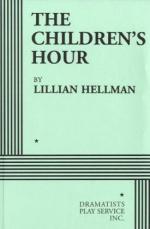|
This section contains 475 words (approx. 2 pages at 400 words per page) |

|
The Children's Hour Summary & Study Guide Description
The Children's Hour Summary & Study Guide includes comprehensive information and analysis to help you understand the book. This study guide contains the following sections:
This detailed literature summary also contains Bibliography and a Free Quiz on The Children's Hour by Lillian Hellman.
Lillian Hellman's The Children's Hour premiered in New York at the Maxine Elliot Theatre, on November 20, 1934, with a cast of relatively unknown actors. The play was based on an essay the playwright had encountered titled "Closed Doors; or, The Great Drumsheugh Case." It related the true story of two female teachers who were condemned by their community when a student alleged that they were having a homosexual affair. It was produced and directed by Herman Shumlin, for whom Hellman had been working as a script reader. Shumlin knew the risks of bringing the work of a novice playwright directly to the Broadway stage without an out-of-. town tryout, but he had great faith in the play. From the outset, he was confident of the work's quality and felt that it needed little of the refinement and rewriting that is generally done during preview performances
The risk paid great dividends. The play was a major commercial success and almost immediately earned the playwright a lasting place in the American theater. It remained on the boards at the Elliot for 691 performances, which, at the time, set the record for the longest single-venue run in theater history. Among other things, it earned Hellman about $ 125,000 and netted her further career opportunities, including a contract for writing the first film adaptation of the work
The production was helped by its reviews, which were generally favorable. Some, like those of Brooks Atkinson and Joseph Wood Krutch, did complain about the last part of the play, which they was felt was too melodramatic in its final array of coincidences and too heavy in its moralizing; but most critics found little to complain of and enthusiastically welcomed Hellman as one of Broadway's newest luminaries.
Because of its theme, The Children's Hour also gained some notoriety. Initially, it was banned in Boston, Chicago, and London. The flap over its content also scared off the Pulitzer Prize selection committee, which refused to attend a single per- formance of the play. The uproar and likely censorship by the Hays Office also forced Hellman to turn the central adult conflict into a standard love and jealousy triangle in her film adaptation, released in 1936 as These Three.
Ironically, it was the theme of the play that kept it relevant enough to lead to a revision and stage revival in 1952, at which time it also served as an oblique criticism of the hearings then being conducted by the House Un-American Activities Committee. By that time, Hellman had been blacklisted (forbidden employment for her political beliefs) in Hollywood, which added fuel to the continuing controversy over the play. It remained banned in Boston, but by 1962, when another screen adaptation was released, its frank if understated treatment of the lesbian theme no longer fanned the fires of moral outrage, allowing a much more objective assessment of Hellman's considerable achievement.
Read more from the Study Guide
|
This section contains 475 words (approx. 2 pages at 400 words per page) |

|



